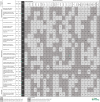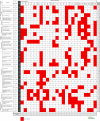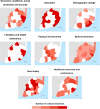Assessing Urban Health Inequities through a Multidimensional and Participatory Framework: Evidence from the EURO-HEALTHY Project
- PMID: 32860097
- PMCID: PMC7454139
- DOI: 10.1007/s11524-020-00471-5
Assessing Urban Health Inequities through a Multidimensional and Participatory Framework: Evidence from the EURO-HEALTHY Project
Abstract
Urban health inequities often reflect and follow the geographic patterns of inequality in the social, economic and environmental conditions within a city-the so-called determinants of health. Evidence of patterns within these conditions can support decision-making by identifying where action is urgent and which policies and interventions are needed to mitigate negative impacts and enhance positive impacts. Within the scope of the EU-funded project EURO-HEALTHY (Shaping EUROpean policies to promote HEALTH equitY), the City of Lisbon was selected as a case study to apply a multidimensional and participatory assessment approach of urban health whose purpose was to inform the evaluation of policies and interventions with potential to address local health gaps. In this paper, we present the set of indicators identified as drivers of urban health inequities within the City of Lisbon, exploring the added value of using a spatial indicator framework together with a participation process to orient a place-based assessment and to inform policies aimed at reducing health inequities. Two workshops with a panel of local stakeholders from health and social care services, municipal departments (e.g. urban planning, environment, social rights and education) and non-governmental and community-based organizations were organized. The aim was to engage local stakeholders to identify locally critical situations and select indicators of health determinants from a spatial equity perspective. To support the analysis, a matrix of 46 indicators of health determinants, with data disaggregated at the city neighbourhood scale, was constructed and was complemented with maps. The panel identified critical situations for urban health equity in 28 indicators across eight intervention axes: economic conditions, social protection and security; education; demographic change; lifestyles and behaviours; physical environment; built environment; road safety and healthcare resources and performance. The geographical distribution of identified critical situations showed that all 24 city neighbourhoods presented one or more problems. A group of neighbourhoods systematically perform worse in most indicators from different intervention axes, requiring not only priority action but mainly a multi- and intersectoral policy response. The indicator matrices and maps have provided a snapshot of urban inequities across different intervention axes, making a compelling argument for boosting intersectoral work across municipal departments and local stakeholders in the City of Lisbon. This study, by integrating local evidence in combination with social elements, pinpoints the importance of a place-based approach for assessing urban health equity.
Keywords: Determinants of health; Indicators; Lisbon; Local level; Multidimensional assessment; Participatory approach; Stakeholder engagement; Urban health equity.
Conflict of interest statement
The authors declare that they have no conflict of interest.
Figures







Similar articles
-
Urban health: an example of a "health in all policies" approach in the context of SDGs implementation.Global Health. 2019 Dec 18;15(1):87. doi: 10.1186/s12992-019-0529-z. Global Health. 2019. PMID: 31856877 Free PMC article.
-
The Experience of Implementing Urban HEART Barcelona: a Tool for Action.J Urban Health. 2018 Oct;95(5):647-661. doi: 10.1007/s11524-017-0194-6. J Urban Health. 2018. PMID: 29039133 Free PMC article.
-
Prioritizing action on health inequities in cities: An evaluation of Urban Health Equity Assessment and Response Tool (Urban HEART) in 15 cities from Asia and Africa.Soc Sci Med. 2015 Nov;145:237-42. doi: 10.1016/j.socscimed.2015.09.031. Epub 2015 Sep 30. Soc Sci Med. 2015. PMID: 26456133 Free PMC article.
-
Use of Urban Health Indicator Tools by Built Environment Policy- and Decision-Makers: a Systematic Review and Narrative Synthesis.J Urban Health. 2020 Jun;97(3):418-435. doi: 10.1007/s11524-019-00378-w. J Urban Health. 2020. PMID: 31482385 Free PMC article.
-
Urban Health Indicator Tools of the Physical Environment: a Systematic Review.J Urban Health. 2018 Oct;95(5):613-646. doi: 10.1007/s11524-018-0228-8. J Urban Health. 2018. PMID: 29663118 Free PMC article.
Cited by
-
Health Equity Impact Assessment (HEIA) reporting tool: developing a checklist for policymakers.Int J Equity Health. 2023 Nov 18;22(1):241. doi: 10.1186/s12939-023-02031-0. Int J Equity Health. 2023. PMID: 37980523 Free PMC article.
-
Implementing a social prescribing program in primary care units in Portugal: A qualitative study exploring enablers, barriers and lessons learned from the perspectives of stakeholders involved in the program implementation.PLoS One. 2024 Jun 28;19(6):e0306404. doi: 10.1371/journal.pone.0306404. eCollection 2024. PLoS One. 2024. PMID: 38941342 Free PMC article.
-
Urban Governance, Multisectoral Action, and Civic Engagement for Population Health, Wellbeing, and Equity in Urban Settings: A Systematic Review.Int J Public Health. 2023 Aug 30;68:1605772. doi: 10.3389/ijph.2023.1605772. eCollection 2023. Int J Public Health. 2023. PMID: 37719658 Free PMC article.
-
The Association between Material Deprivation and Avoidable Mortality in Lisbon, Portugal.Int J Environ Res Public Health. 2020 Nov 17;17(22):8517. doi: 10.3390/ijerph17228517. Int J Environ Res Public Health. 2020. PMID: 33212953 Free PMC article.
-
Intersectoral Partnerships Between Local Governments and Health Organisations in High-Income Contexts: A Scoping Review.Int J Health Policy Manag. 2024;13:7841. doi: 10.34172/ijhpm.2024.7841. Epub 2024 Feb 18. Int J Health Policy Manag. 2024. PMID: 38618835 Free PMC article.
References
-
- WHO and UN-Habitat. Hidden Cities: Unmasking and Overcoming Health Inequities in Urban Settings. Kobe, Japan; 2010. http://www.who.int/kobe_centre/%0Apublications/hidden_cities2010/en/. Accessed 15 Dec 2019
-
- WHO and UN-Habitat. Global Report on Urban Health: Equitable, Healthier Cities for Sustainable Development. Kobe, Japan; 2016.
-
- Santana P, Costa C, Freitas Â, et al. In: Atlas of Population Health in European Union Regions. Santana P, et al., editors. Coimbra: Imprensa da Universidade de Coimbra; 2017.
-
- Costa C, Santana P, Dimitroulopoulou S, Burstrom B, Borrell C, Schweikart J, Dzurova D, Zangarini N, Katsouyanni K, Deboseree P, Freitas Â, Mitsakou C, Samoli E, Vardoulakis S, Marí Dell’Olmo M, Gotsens M, Lustigova M, Corman D, Costa G. Population health inequalities across and within European metropolitan areas through the Lens of the EURO-HEALTHY Population Health Index. Int J Environ Res Public Health. 2019;16(5):836. doi: 10.3390/ijerph16050836. - DOI - PMC - PubMed
-
- Corburn J Healthy city planning: from neighbourhood to national health equity. 2013. 10.4324/9780203772249.
Publication types
MeSH terms
LinkOut - more resources
Full Text Sources
Medical

